
Two years before she got the Supergirl gig (Action Comics #252), Linda Lee could be found hanging out on beaches, flirting, and wearing big hats.

Superman soon put a stop to that kind of behaviour.

 The following day at the same "deserted" spot a high speed police chase occurs, and no sooner than the escaping gangsters have been rounded up an enemy submarine surfaces to offload some
The following day at the same "deserted" spot a high speed police chase occurs, and no sooner than the escaping gangsters have been rounded up an enemy submarine surfaces to offload some  saboteurs. Steve and Wondy drive into town only to have a girder from a construction site fall on them, a lion escape from a circus, and bank robbers come charging out of the building in front of which they have just parked.
saboteurs. Steve and Wondy drive into town only to have a girder from a construction site fall on them, a lion escape from a circus, and bank robbers come charging out of the building in front of which they have just parked.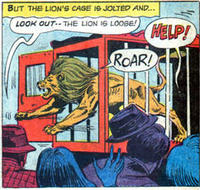 Stuff like that just doesn't happen to ordinary people. Well, not all on the same day, anyhow. And if it did. it would qualify as being the most exciting day of their life. For a superhero it's barely worth a mention in their diary because every day is like that.
Stuff like that just doesn't happen to ordinary people. Well, not all on the same day, anyhow. And if it did. it would qualify as being the most exciting day of their life. For a superhero it's barely worth a mention in their diary because every day is like that.
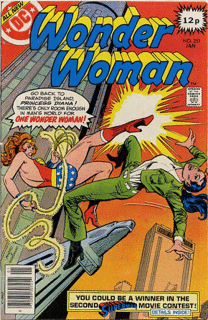 Wonder Woman #243 - 251
Wonder Woman #243 - 251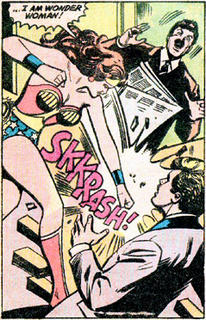 To celebrate Wonder Woman's 250th issue we get a dramatic twist as another amazon, Orana (5) challenges Diana's claim to the title of Wonder Woman under an ancient law that nobody has ever mentioned before. Though how ancient can a law be that is designed to cover the specific issue of who gets to be Wonder Woman, since the position was only created quite recently?(6)
To celebrate Wonder Woman's 250th issue we get a dramatic twist as another amazon, Orana (5) challenges Diana's claim to the title of Wonder Woman under an ancient law that nobody has ever mentioned before. Though how ancient can a law be that is designed to cover the specific issue of who gets to be Wonder Woman, since the position was only created quite recently?(6) 1) It's a neutron bomb. Since the fight is taking place above the target it can't be that far from ground zero. The villain, Warhead (11) is supposed to be an international arms dealer, and yet he is too stupid to realise that sitting over a nuclear explosion is a bad idea.
1) It's a neutron bomb. Since the fight is taking place above the target it can't be that far from ground zero. The villain, Warhead (11) is supposed to be an international arms dealer, and yet he is too stupid to realise that sitting over a nuclear explosion is a bad idea. 3) Diana might be strong enough to catch the bomb but she is standing on the wing of an aircraft at the time. Even if the robot plane is so absurdly strong that she wasn't driven through the wing, the impact should have rolled it over.
3) Diana might be strong enough to catch the bomb but she is standing on the wing of an aircraft at the time. Even if the robot plane is so absurdly strong that she wasn't driven through the wing, the impact should have rolled it over. Back in the golden age there were many different kinds of comics as new titles appeared to follow every popular fad of the day, and Moon Girl wasn't the only one to cross the genre boundaries in hopes of finding an audience. But while Marvel singlemindedly co-opted every other genre and made superheroes out of them (cowboy superheroes, funny animal superheroes, horror superheroes, kung fu superheroes...), other companies produced more inventive hybrids such as Cowgirl Romances and Weird War Tales.
Back in the golden age there were many different kinds of comics as new titles appeared to follow every popular fad of the day, and Moon Girl wasn't the only one to cross the genre boundaries in hopes of finding an audience. But while Marvel singlemindedly co-opted every other genre and made superheroes out of them (cowboy superheroes, funny animal superheroes, horror superheroes, kung fu superheroes...), other companies produced more inventive hybrids such as Cowgirl Romances and Weird War Tales. To remind you, the setup is this: Wonder Woman has delivered Steve Trevor to the military hospital but wants to remain close to him. She finds a nurse who is weeping over being parted from her fiance who has gone off to South America because she cannot afford to join him. Wondy offers to finance her trip if the woman named Diana Prince will trade places with her since, not only do they have the same name but they are also conveniently near identical to look at. The somewhat naive nurse then agrees to hand over all her identity papers to this strange foreign woman in exchange for sufficient money to take her far away, and never considers that this is not the most appropriate thing to do when your country is at war, and meanwhile nobody in the hospital notices the substitution, or even that one of the staff has acquired muscles and a foreign accent.
To remind you, the setup is this: Wonder Woman has delivered Steve Trevor to the military hospital but wants to remain close to him. She finds a nurse who is weeping over being parted from her fiance who has gone off to South America because she cannot afford to join him. Wondy offers to finance her trip if the woman named Diana Prince will trade places with her since, not only do they have the same name but they are also conveniently near identical to look at. The somewhat naive nurse then agrees to hand over all her identity papers to this strange foreign woman in exchange for sufficient money to take her far away, and never considers that this is not the most appropriate thing to do when your country is at war, and meanwhile nobody in the hospital notices the substitution, or even that one of the staff has acquired muscles and a foreign accent. In Sensation Comics #9 (1942) we find her returned to the city now married and with a small child. Her husband is trying to sell a new kind of artillery shell he has invented but is so far unable to interest anyone and so real Diana Prince (now Diana White) contacts WW Diana
In Sensation Comics #9 (1942) we find her returned to the city now married and with a small child. Her husband is trying to sell a new kind of artillery shell he has invented but is so far unable to interest anyone and so real Diana Prince (now Diana White) contacts WW Diana  Prince to say she wants her job back. After all sorts of fun with enemy spies, WW gets the husband's invention taken up by the military, and so Real Diana Prince can go back to being a full time mother and getting her hair restyled so they don't look so similar.
Prince to say she wants her job back. After all sorts of fun with enemy spies, WW gets the husband's invention taken up by the military, and so Real Diana Prince can go back to being a full time mother and getting her hair restyled so they don't look so similar. she wants her job back, although this time it is because her fiance (they didn't get married yet in this version) is lost in the mountains and she doesn't expect to see him again. Either this is subtle blackmail (come find my fiance or I'll expose you) or disguised cry for help (if I tell you about my problem maybe you'll come fix it), because taken straight it doesn't make a lot of sense. Wonder Woman of course rushes off to help her. It
she wants her job back, although this time it is because her fiance (they didn't get married yet in this version) is lost in the mountains and she doesn't expect to see him again. Either this is subtle blackmail (come find my fiance or I'll expose you) or disguised cry for help (if I tell you about my problem maybe you'll come fix it), because taken straight it doesn't make a lot of sense. Wonder Woman of course rushes off to help her. It  transpires that Bill, the fiance has been captured by a lost tribe of Mayans, or possibly incans (it's hard to tell as they are a bit generic) who compell WW to undergo several trials in order to save him. Luckily he has found a wealth of rare minerals in the sacred mountain so once again real Diana Prince can look forward to the good life exploiting native lands and doesn't need her job back.
transpires that Bill, the fiance has been captured by a lost tribe of Mayans, or possibly incans (it's hard to tell as they are a bit generic) who compell WW to undergo several trials in order to save him. Luckily he has found a wealth of rare minerals in the sacred mountain so once again real Diana Prince can look forward to the good life exploiting native lands and doesn't need her job back.
 Moon Girl may have been a poor copy of Wonder Woman, but there is evidence to suggest that she had a copy of her own in the shape of Sun Girl. It's entirely circumstancial, but it seems more than coincidence that within six months of the launch of Moon Girl, another female crime fighter
Moon Girl may have been a poor copy of Wonder Woman, but there is evidence to suggest that she had a copy of her own in the shape of Sun Girl. It's entirely circumstancial, but it seems more than coincidence that within six months of the launch of Moon Girl, another female crime fighter 
 should arrive with such an obviously similar name. And then there's the appearance. If you took Moon Girl's top and gave it a higher neckline and a lower waist, it would look very similar to that worn by Sun Girl, and the hairstyle is identical, just different colours.
should arrive with such an obviously similar name. And then there's the appearance. If you took Moon Girl's top and gave it a higher neckline and a lower waist, it would look very similar to that worn by Sun Girl, and the hairstyle is identical, just different colours.
 ways this is down to the art of Ken Bald, whose creative and playful panel layouts sizzle with energy, as does Sun Girl herself whenever he gets a chance to show off her long legs.
ways this is down to the art of Ken Bald, whose creative and playful panel layouts sizzle with energy, as does Sun Girl herself whenever he gets a chance to show off her long legs.
 an otherwise so entertaining comic. At least the other Sun Girl story in the issue goes some way to redressing the balance with a light (
an otherwise so entertaining comic. At least the other Sun Girl story in the issue goes some way to redressing the balance with a light ( in more ways than one) fantasy of a style that reeks of silver age DC despite being published by Marvel in 1949. But I am also left wondering why the cover to issue 3 does not depict any stories inside. Unlike the more symbolic pin up covers to the previous issues this one is clearly a scene from a specific story.
in more ways than one) fantasy of a style that reeks of silver age DC despite being published by Marvel in 1949. But I am also left wondering why the cover to issue 3 does not depict any stories inside. Unlike the more symbolic pin up covers to the previous issues this one is clearly a scene from a specific story.
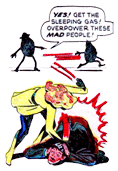 guest shot in other Marvel titles and a couple of short back ups in The Human Torch. After this she was not seen again until Roy Thomas featured someone supposed to be Sun Girl in his Saga of the Original Human Torch miniseries of 1990. Although this pupports to be a retelling of the Torch's adventures in the 1940's the version of Sun Girl depicted here is unrecogniseable. This sad wannabee Torch groupie bears no resemblence to the sassy, sexy, and self-assured heroine of the golden age.
guest shot in other Marvel titles and a couple of short back ups in The Human Torch. After this she was not seen again until Roy Thomas featured someone supposed to be Sun Girl in his Saga of the Original Human Torch miniseries of 1990. Although this pupports to be a retelling of the Torch's adventures in the 1940's the version of Sun Girl depicted here is unrecogniseable. This sad wannabee Torch groupie bears no resemblence to the sassy, sexy, and self-assured heroine of the golden age.
 In the wacky world of comics you can hardly throw a rock without hitting a copy, parody, or homage to Superman, and every writer at one time or another seems to feel the need to do their own take on Batman, but historically, Wonder Woman clones have been fewer and further between.
In the wacky world of comics you can hardly throw a rock without hitting a copy, parody, or homage to Superman, and every writer at one time or another seems to feel the need to do their own take on Batman, but historically, Wonder Woman clones have been fewer and further between.  One of those few was Moon Girl, and the only interesting thing about her was her struggle to find an identity.
One of those few was Moon Girl, and the only interesting thing about her was her struggle to find an identity. It was 1947 and the first wave of the Golden Age was receding. EC comics had yet to establish an identity as the home of horror and were trying a variety of different genres. Almost their only foray into superhero comics was Moon Girl, and they didn't waste any expense on originality. Her origin is a complete steal from Wonder Woman: Princess of an exotic foreign land with a tradition of powerful women wins a contest and moves to America where she fights crime in a costume composed of red, yellow, and blue. With moons instead of stars on her pants, and greek sandals. She even had a cheap copy of Wonder Woman's robot plane. It was far from invisible, but it was remote controlled by her own mental commands like a well trained dog... that, er, flies.
It was 1947 and the first wave of the Golden Age was receding. EC comics had yet to establish an identity as the home of horror and were trying a variety of different genres. Almost their only foray into superhero comics was Moon Girl, and they didn't waste any expense on originality. Her origin is a complete steal from Wonder Woman: Princess of an exotic foreign land with a tradition of powerful women wins a contest and moves to America where she fights crime in a costume composed of red, yellow, and blue. With moons instead of stars on her pants, and greek sandals. She even had a cheap copy of Wonder Woman's robot plane. It was far from invisible, but it was remote controlled by her own mental commands like a well trained dog... that, er, flies. The writing is so clumsy that at times it feels like you are reading a translation by someone for whom english is not a native language, and Moonie is a bland cypher with all the depth of the paper she appears on. In her secret identity of a teacher with the somewhat obvious name of Clare Lune she seems to randomly move jobs to wherever the dictates of the
The writing is so clumsy that at times it feels like you are reading a translation by someone for whom english is not a native language, and Moonie is a bland cypher with all the depth of the paper she appears on. In her secret identity of a teacher with the somewhat obvious name of Clare Lune she seems to randomly move jobs to wherever the dictates of the  story require, her sidekick/boyfriend trailing behind whenever she remembers to tell him where she's going. And she's even worse than Wondy for explaining the plot out loud while alone. Her only vaguely original aspect is her magic moonstone, which increases her naturally high strength to whatever level is required by the plot, but fails to affect her intelligence. Thus to prevent a rocket hitting a large skyscraper, she picks up the skyscraper and moves it out of the path of the rocket rather than stopping the rocket before it gets there. It seems to have a variety of other powers as well, becoming all too reminiscent of Green Lantern's ring at times. And of course she invariably loses it at some crucial moment in order to add some tension to the story.
story require, her sidekick/boyfriend trailing behind whenever she remembers to tell him where she's going. And she's even worse than Wondy for explaining the plot out loud while alone. Her only vaguely original aspect is her magic moonstone, which increases her naturally high strength to whatever level is required by the plot, but fails to affect her intelligence. Thus to prevent a rocket hitting a large skyscraper, she picks up the skyscraper and moves it out of the path of the rocket rather than stopping the rocket before it gets there. It seems to have a variety of other powers as well, becoming all too reminiscent of Green Lantern's ring at times. And of course she invariably loses it at some crucial moment in order to add some tension to the story. And then in issue #7 the title becomes Moon Girl Fights Crime following the popular trend of tough crime comics, and two issues later it takes an unexpected turn into romance stories, attempting to catch another trend. And it's here that we see the only real stroke of genius as a minor alteration completely changes the meaning of the title as it becomes A Moon, a Girl... Romance.
And then in issue #7 the title becomes Moon Girl Fights Crime following the popular trend of tough crime comics, and two issues later it takes an unexpected turn into romance stories, attempting to catch another trend. And it's here that we see the only real stroke of genius as a minor alteration completely changes the meaning of the title as it becomes A Moon, a Girl... Romance.  In fact Moon Girl does even more genre hopping than this. Issue #2's cover featured "The Battle of the Congo" is a jungle story, and issue #4 contains possibly EC's first ventures into the realms of horror with "Vampire of the Bayous" followed by "Zombie Terror" in #5. Based on the information available I'd speculate that she even slipped into science fiction territory at times, and if I found her in a western it wouldn't surprise me for a second.
In fact Moon Girl does even more genre hopping than this. Issue #2's cover featured "The Battle of the Congo" is a jungle story, and issue #4 contains possibly EC's first ventures into the realms of horror with "Vampire of the Bayous" followed by "Zombie Terror" in #5. Based on the information available I'd speculate that she even slipped into science fiction territory at times, and if I found her in a western it wouldn't surprise me for a second. The chameleon nature of the title could have given Moon Girl a niche in history as the symbolic hybrid who embraced all the genres (she even appeared in a funny animal book) of the comics world in the days when it had genres - A renaissance golden (age) girl. Sadly, the universally dreadful standard of the writing and the bland pedestrian art, whatever the style du jour might be, condemmed her to obscurity as a cheap Wonder Woman knock off.
The chameleon nature of the title could have given Moon Girl a niche in history as the symbolic hybrid who embraced all the genres (she even appeared in a funny animal book) of the comics world in the days when it had genres - A renaissance golden (age) girl. Sadly, the universally dreadful standard of the writing and the bland pedestrian art, whatever the style du jour might be, condemmed her to obscurity as a cheap Wonder Woman knock off.
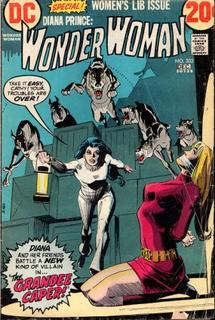 I am now delighted to be able to report that I have evidence to support this theory. I don't normally quote so extensively from articles readily available elsewhere on the web but this is so relevent I feel I have to. In an interview with Random House, writer Samuel Delaney says:
I am now delighted to be able to report that I have evidence to support this theory. I don't normally quote so extensively from articles readily available elsewhere on the web but this is so relevent I feel I have to. In an interview with Random House, writer Samuel Delaney says:


 From the outset Marsha is portrayed as struggling with her weight. Her big problem is that she enjoys food too much. For several issues subsequent to the new characters' introduction they appear for a grand total of one page per issue in a brief domestic scene entirely unrelated to the main story. Marsha is usually eating or encouraging others to eat. Her other main interest appears to be dyeing her hair.
From the outset Marsha is portrayed as struggling with her weight. Her big problem is that she enjoys food too much. For several issues subsequent to the new characters' introduction they appear for a grand total of one page per issue in a brief domestic scene entirely unrelated to the main story. Marsha is usually eating or encouraging others to eat. Her other main interest appears to be dyeing her hair.
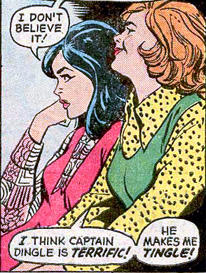 Eventually Marsha and the Kristen do get to participate in the main story, being hypnotised by clowns and going on dangerous hikes in the country. But then what else would they expect when hanging out with Lois Lane, a woman who can't stand near a window without falling out of it.
Eventually Marsha and the Kristen do get to participate in the main story, being hypnotised by clowns and going on dangerous hikes in the country. But then what else would they expect when hanging out with Lois Lane, a woman who can't stand near a window without falling out of it.
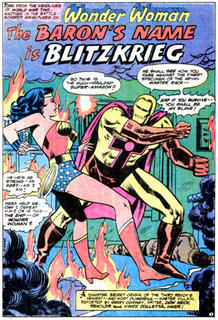 World's Finest #244 - 250
World's Finest #244 - 250 With the appearance of the TV show DC made the obvious move of giving Wonder Woman a second comic. Well, sort of. They gave her a back up spot in World's Finest, backing up the traditional Superman/Batman teamups along with Green Arrow, Black Canary, and Vigilante (later replaced by The Creeper) which was at that point running to 80 pages and bimonthly.
The Wonder Woman stories featured here are written by Gerry Conway (regular writer on WW by this point) and are uniformly awful. WW gets to fight horribly disfigured mad nazi spies(1) dressed in an even more ludicrous costumes than the ones in the main comic,only this time mostly set in London between April and August 1942(2).
Conway does make an effort to tie in some golden age continuity here, as he does in the main series. In this case it means bringing back villain Doctor Psycho for an inevitable WW team up adventure with Sgt. Rock.(3) Though throwing in some aliens from a 15 year old issue of Mystery in Space (4), duped into working for the nazis by Dr Psycho is probably overdoing it for a single story, even a two-parter.
And after the big anniversary crossover with the other World's Finest feature characters, Superman, Batman, Green Arrow, and Black Canary, which once again Wonder Woman is doomed to forget(5), the stories revert to present day Earth 1 adventures. Presumably they must have assumed anyone reading World's Finest was also reading Wonder Woman as there is no explanation given here for the change of scene.
Next: As I was saying before I was rudely interrupted by World War 2...
Notes
1. No wonder the nazis lost the war if their idea of inconspicuous was someone who was grotesquely disfigured and wore a bright yellow nazi uniform. And what kind of strategy is german high command using to pick their lead field agents that results in deformed freaks with horrible dress sense, anyway? Couldn't they find anyone more normal looking who was qualified to do the job?
2. A busy period for her, what with having to pop back to America in June for WW #239.
3. The funny thing is that long time WW writer Robert Kanigher was also the main writer on Sgt. Rock, but never got the opportunity to get them together himself.
4. Actually the aliens referenced in Mystery in Space #73 are never seen there and have in fact died out a million years previously, and their only notable characteristic (their legacy of a superweapon) does not feature in the WF story, so I am at a loss to understand why they are linked to this story or even mentioned at all.
5. Poor thing.
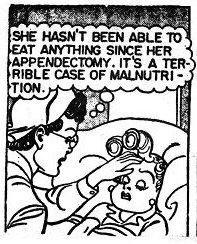 I've always felt that Etta Candy was poorly treated by writers of Wonder Woman. She was always the pretty girl's fat friend; usually little more than a caricature obsessively stuffing her face with chocolates regardless of the situation, but now I find that not only is there much more to this, but it is all apparently Wonder Woman's fault!
I've always felt that Etta Candy was poorly treated by writers of Wonder Woman. She was always the pretty girl's fat friend; usually little more than a caricature obsessively stuffing her face with chocolates regardless of the situation, but now I find that not only is there much more to this, but it is all apparently Wonder Woman's fault!
 Etta obviously takes it to heart when Diana tells her that Wonder Woman says the chocolates are good for her, and thus she starts on a lifelong obsession.
Etta obviously takes it to heart when Diana tells her that Wonder Woman says the chocolates are good for her, and thus she starts on a lifelong obsession.
 It was Wonder Woman v1 #136 and after many years (not that many. It was old when I first read it) I finally got to read it again today. I was surprised when I saw the cover, as it rang no bells at all. Which is odd, because it's quite memorable. Far from accentuating her giant size, the composition of the cover showing her stuck between two skyscrapers makes it look more like she is being eaten by a giant alligator-like mouth.
It was Wonder Woman v1 #136 and after many years (not that many. It was old when I first read it) I finally got to read it again today. I was surprised when I saw the cover, as it rang no bells at all. Which is odd, because it's quite memorable. Far from accentuating her giant size, the composition of the cover showing her stuck between two skyscrapers makes it look more like she is being eaten by a giant alligator-like mouth. Some stories are timeless. I enjoyed it at the age of 8 and I enjoyed it again today. Because it's a big, exciting, very silly story where everything comes right in the end. We could do with a few more like this now.
Some stories are timeless. I enjoyed it at the age of 8 and I enjoyed it again today. Because it's a big, exciting, very silly story where everything comes right in the end. We could do with a few more like this now.
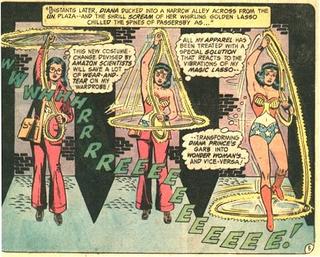 have been "scientifically treated by amazon scientists" so that all she needs to do is twirl her magic lasso and her ordinary clothes are replaced with her fighting costume.
have been "scientifically treated by amazon scientists" so that all she needs to do is twirl her magic lasso and her ordinary clothes are replaced with her fighting costume.